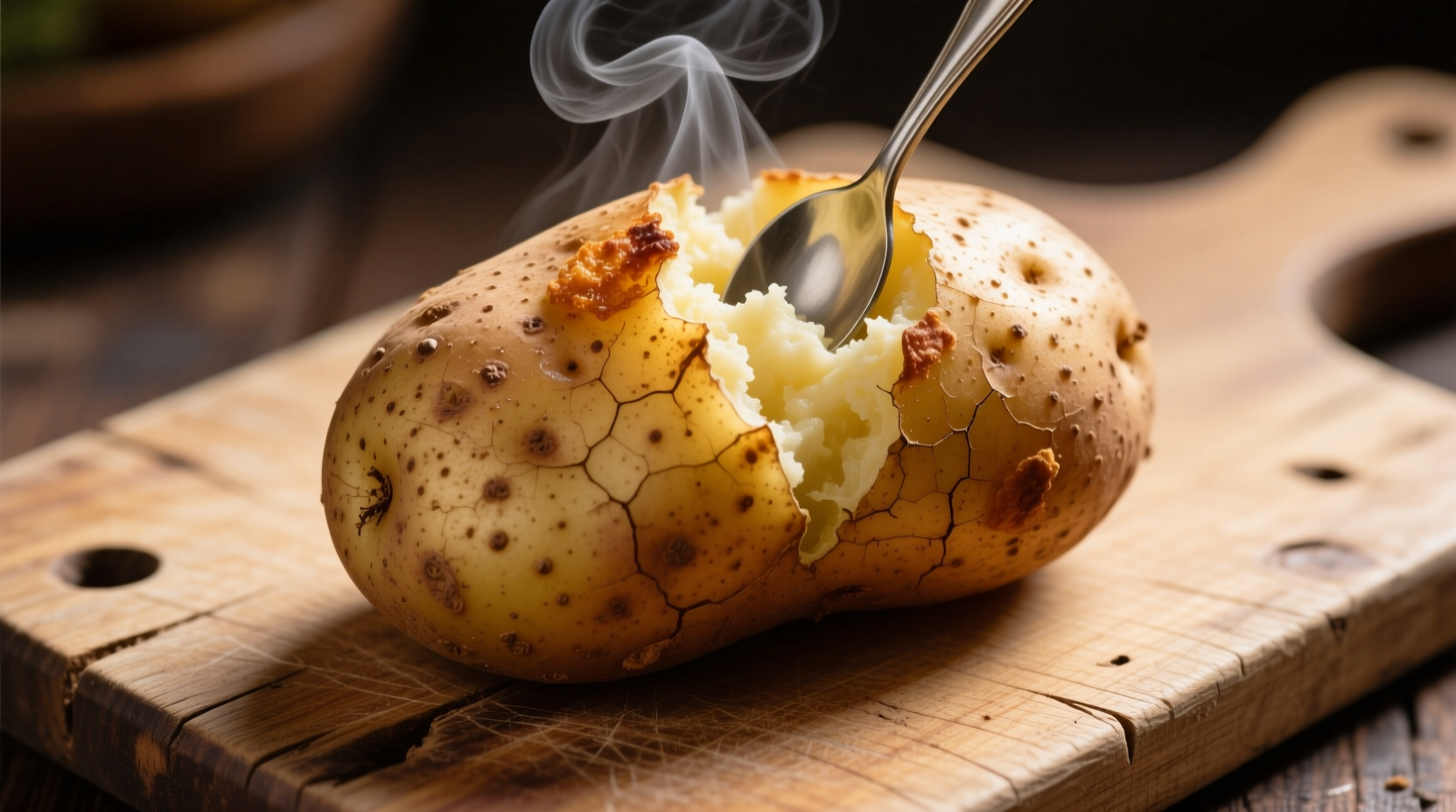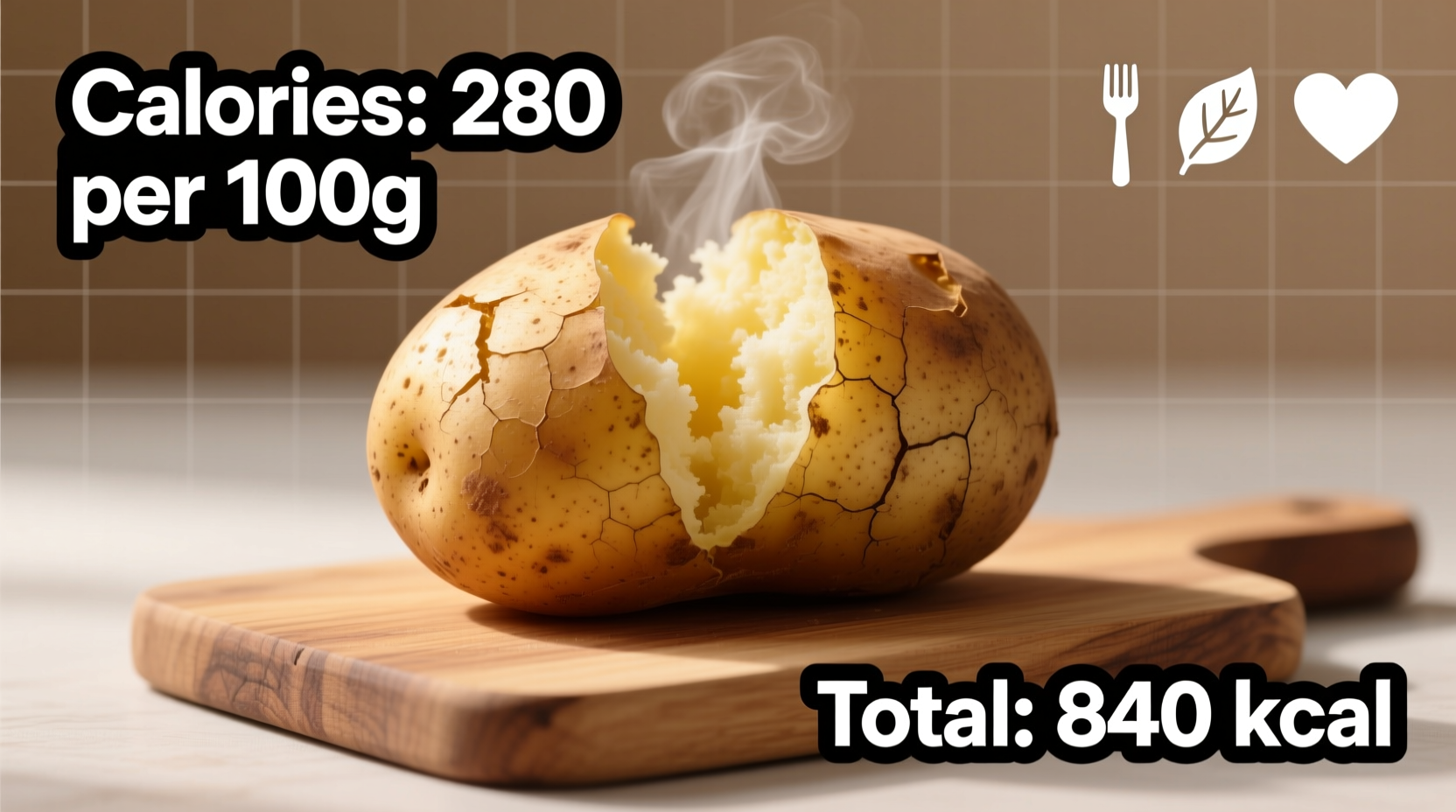Understanding Large Baked Potato Nutrition: Facts You Need
When planning meals or tracking your daily intake, knowing the exact nutritional profile of common foods is essential. A large baked potato often serves as a staple side dish or main component in many diets, but its actual calorie count and nutritional value can vary based on preparation methods and serving size.
What Defines a "Large" Baked Potato?
The USDA defines a large potato as weighing approximately 300 grams (about 10.6 ounces) with skin. This size typically measures 3-4 inches in diameter and yields about 1.5 cups when diced. Understanding these measurements helps ensure accurate calorie tracking.
| Size Classification | Weight (grams) | Calories | Carbohydrates |
|---|---|---|---|
| Small (2"-3" diameter) | 138g | 110 | 26g |
| Medium (3"-4" diameter) | 173g | 140 | 33g |
| Large (3"-4.25" diameter) | 300g | 274 | 63g |
| Extra Large (4.25"+ diameter) | 369g | 334 | 77g |
Nutritional Breakdown of a Large Baked Potato
Beyond calories, a large baked potato offers significant nutritional benefits. According to the USDA FoodData Central database, one large baked potato with skin provides:
- Calories: 274
- Protein: 7g (about 14% of daily value)
- Carbohydrates: 63g (21% of daily value)
- Dietary Fiber: 6.3g (25% of daily value)
- Potassium: 1690mg (48% of daily value)
- Vitamin C: 38mg (42% of daily value)
- Vitamin B6: 0.7mg (41% of daily value)
- Magnesium: 85mg (20% of daily value)
These values come directly from the USDA FoodData Central, the authoritative source for nutritional information in the United States.

How Preparation Methods Affect Calorie Count
The way you prepare your baked potato significantly impacts its nutritional profile. While the base potato remains consistent, additions can dramatically increase calories:
- With skin: 274 calories (recommended for maximum fiber and nutrients)
- Without skin: 239 calories (but you lose nearly half the fiber content)
- With 1 tbsp butter: Adds 102 calories (total 376)
- With 2 tbsp sour cream: Adds 56 calories (total 330)
- With 1 oz cheddar cheese: Adds 114 calories (total 388)
- Loaded baked potato (typical restaurant serving): Can exceed 600 calories
Large Baked Potato in Different Diet Contexts
Understanding how a large baked potato fits into various dietary approaches helps you make informed choices:
| Diet Type | Considerations | Recommended Serving |
|---|---|---|
| Weight Management | High volume, low calorie density makes it filling | 1 medium potato with healthy toppings |
| Diabetes Management | Moderate glycemic index (85); pair with protein/fat | Small portion with skin, balanced with protein |
| Low-Carb/Keto | Too high in carbs for standard keto protocols | Not recommended; consider cauliflower alternatives |
| Athletic Performance | Excellent carbohydrate source for energy replenishment | Large potato pre- or post-workout with protein |
Registered dietitians often recommend including the skin for maximum nutritional benefit, as it contains nearly half the fiber and significant amounts of vitamins and minerals. The American Diabetes Association notes that while potatoes have a relatively high glycemic index, their glycemic load is moderate when consumed in appropriate portions, especially when eaten with the skin and paired with protein or healthy fats.
Practical Tips for Enjoying Baked Potatoes While Managing Calories
Antonio Rodriguez, our culinary expert, shares these practical strategies for making baked potatoes work within your dietary goals:
- Keep the skin on - This adds fiber which helps with satiety and blood sugar management
- Choose smart toppings - Try Greek yogurt instead of sour cream, salsa instead of cheese
- Control portion size - A medium potato often provides sufficient carbohydrates
- Pair with protein - Add grilled chicken or black beans to balance the meal
- Cool before eating - Allowing cooked potatoes to cool increases resistant starch, which has metabolic benefits
"Many people avoid potatoes unnecessarily," Rodriguez explains. "When prepared thoughtfully, a baked potato can be a nutritious, satisfying component of a balanced diet. The key is understanding portion sizes and making smart topping choices that complement your health goals."
Common Misconceptions About Potato Nutrition
Despite their nutritional value, potatoes often face unnecessary criticism. Research published in the American Journal of Clinical Nutrition shows that when prepared healthfully, potatoes can be part of successful weight management strategies. The misconception that potatoes are "empty calories" overlooks their significant potassium content (more than a banana) and vitamin C levels.
Unlike processed carbohydrate sources, whole potatoes provide complex carbohydrates along with fiber, vitamins, and minerals. The key difference lies in preparation methods - baking or boiling preserves nutritional value, while frying or loading with high-calorie toppings transforms them into less healthful options.
How Baked Potatoes Compare to Other Common Sides
Understanding how a large baked potato compares to other common side dishes helps put its nutritional value in perspective:
- White rice (1 cup cooked): 205 calories, 45g carbs, minimal fiber
- Brown rice (1 cup cooked): 218 calories, 45g carbs, 3.5g fiber
- Quinoa (1 cup cooked): 222 calories, 39g carbs, 5g fiber, 8g protein
- Whole wheat pasta (1 cup cooked): 174 calories, 37g carbs, 6g fiber
- Sweet potato (large, baked): 162 calories, 37g carbs, 6.6g fiber, high in vitamin A
While sweet potatoes generally have a nutritional edge with their vitamin A content, regular potatoes provide more potassium and are comparable in fiber when eaten with the skin.
Storage and Preparation Tips for Maximum Nutrition
To preserve the nutritional value of your potatoes:
- Store in a cool, dark place (not the refrigerator)
- Avoid washing before storage to prevent spoilage
- Bake with skin on to retain nutrients
- Allow to cool slightly before eating to increase resistant starch
- Avoid peeling when possible to maintain fiber content
Proper storage prevents the formation of harmful compounds like solanine, which can develop when potatoes are exposed to light. The Academy of Nutrition and Dietetics recommends consuming potatoes within 2-3 weeks of purchase for optimal freshness and nutritional value.
Final Thoughts on Baked Potato Nutrition
A large baked potato offers a nutrient-dense, satisfying food option that can fit into various dietary patterns when prepared thoughtfully. Its combination of complex carbohydrates, fiber, and essential nutrients makes it a valuable component of a balanced diet. By understanding the actual calorie count and nutritional profile, you can make informed decisions about incorporating potatoes into your meal planning without unnecessary restriction or overconsumption.











 浙公网安备
33010002000092号
浙公网安备
33010002000092号 浙B2-20120091-4
浙B2-20120091-4